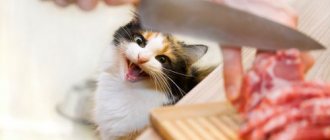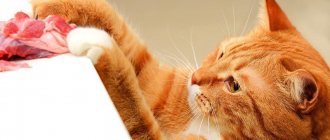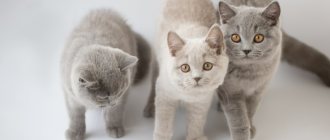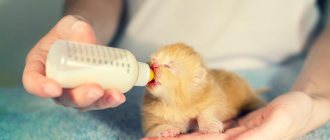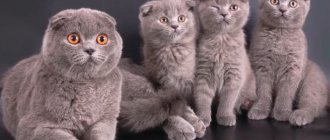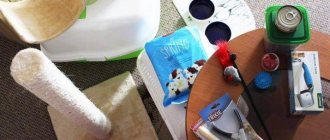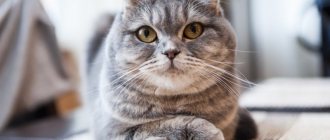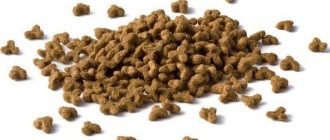Purebred kittens are very picky about their diet. This ordinary cat can be fed soup or bread, and it will be satisfied. In order to raise a Scottish cat that corresponds to the breed characteristics, you should take care of its nutrition from the moment of planned conception. It is very important that the cat from whom you plan to have offspring eats adequately before mating, during pregnancy and several months after the birth of the babies. The milk feeding period is important for the proper functioning of the gastrointestinal tract of babies. When trying to find out what to feed Scottish kittens, there are several important points to consider.
Is it possible to feed Scottish kittens milk?
We will try to answer what care and feeding the Scottish Fold cat requires, formulating feeding rules in the following points:
Cats need a lot of water to digest, especially dry food. Therefore, do not let your pet feel its lack. Fresh water in a clean bowl should be visible.
How to feed properly is a question that causes a lot of controversy. But, perhaps, there is no one who disagrees with the fact that cheap food does not contain a composition suitable for food and health. The animal's interest in them is caused by taste enhancers and special additives that are addictive.
The Scottish Straight cat requires exactly the same nutrition as the Fold cat. The shape of the ears does not depend on nutrition.
The food must be either natural food or special food. Because industrial feed contains calculated nutrients for 1 serving. And for digestion, the body produces 2 different types of enzyme. Such food mixed in 1 meal will harm your cat’s gastrointestinal tract.
As a treat, you shouldn’t change the food manufacturer all the time.
Drinking regime or amount of water for a kitten
Drinking enough drinking water is vital for all cats, including Scottish Fold kittens. A lack of fluid intake can lead to the development of diseases such as urolithiasis.
An adult Scottish Fold should drink up to 250 ml of clean drinking water per day. Pets that eat exclusively dry food drink more than animals whose main diet consists of natural products.
A fold-eared cat may refuse water for various reasons:
- The pet does not like the container in which the water is poured.
- The cat drinks not only from the bowl, but also in other places in the house.
- The pet does not like the taste of water.
As a container, it is better to use glass or ceramic wide bowls with a volume of at least 400-500 ml. Dishes must be washed daily, as the water may turn sour and acquire an unpleasant taste or smell. You can also offer the Scotsman liquid passed through a regular water filter.
Selecting the power type
Every owner is faced with the question of what to feed Scottish Fold cats. The advice from veterinarians is that first of all, the owner must evaluate his time and financial capabilities.
Feeding natural and prepared foods is equally good. And only you can decide what is best to feed your Scottish. It doesn’t matter if you have a straight-eared or a fold-eared cat, make your food choices responsibly and rely on your pet’s preferences.
Natural food
Natural food is not food from the table, but products that completely replace commercial food for Scottish Folds in terms of the amount of nutrients, vitamins and minerals.
Cooking takes a lot of time, but you can be sure of the quality of what the animals eat. For cats, the menu should include sea fish (occasionally), lean meat (beef, chicken, rabbit), fermented milk products, eggs, low-carbohydrate cereals, vegetables, herbs, and vegetable oil.
Ready-made feed
To choose food for Scottish cats, you need to carefully study the basic composition, information about the manufacturer, reviews, then you will decide what is best to feed.
Super premium or holistic food is suitable as a cat's lunch. This can be wet or dry food.
Ready-made food brands such as Royal Canin, Akana, Fest Choice, Hills contain good quality meat and a large amount of vitamins.
Mixed diet
If you have not yet decided what to feed your Scottish Fold, then perhaps a mixed type of feeding will suit you. The advantages of such a diet are variety, the disadvantages are that it is difficult to determine the daily requirement.
It is also worth considering that the Scots love to eat and are prone to overeating. In addition, one feeding should not contain a mixture of natural and ready-made food. This can provoke various diseases.
Advantages of ready-made feeds
Why are more and more owners of kittens switching to ready-made food? Perhaps the secret is that everyone wants to have a kitten, but there is simply no one to care for and feed it. Constantly being busy at work means that owners have no time to boil meat, fish, or grind food to remove bones.
Ready-made food has many advantages. Premium mixtures are designed for feeding cats, taking into account their age, body type, belonging to a specific breed, and are even available for neutered and lactating pets.
Popular foods that are suitable for Scottish babies:
- Wahre Liebe "Junge", produced in Germany. The food contains colostrum, so the product is well absorbed and can be used for feeding from the earliest months. In addition, the food contains chicken and turkey meat, as well as rice, egg and beet pieces. The manufacturer assures that the food can be used to prevent urolithiasis.
- Fans of the fish menu will appreciate Hill's Science Plan Kitten Tuna - dry food, made in the USA. It contains: floured tuna meat, chicken, animal fat, flaxseed, corn, beets, fish oil, Omega-3 and Omega-6 acids. Kittens really like the food. Long-term use helps strengthen the immune system.
- Canadian manufacturers offer high protein dry food 1st Choice Kitten. It contains, in addition to chicken and herring meat, rice, barley, oatmeal, egg powder, tomato and beets. The food is hypoallergenic, therefore suitable for pets suffering from food allergies.
- Another dry food from French manufacturers is Royal Canin British Shorthair Kitten, containing dried poultry meat, extract from cartilage and crustacean shells, fish oil, corn, and chopped beets. According to the annotation, the food is a preventative against joint pathologies.
- For lovers of wet food, the French offer Royal Canin Kitten Instinctive. In addition to meat and meat products, it contains cereals, yeast and milk.
- The manufacturer Purina Pro offers Plan Dental Plus food for small kittens. The unique composition allows you to maintain your pet’s oral cavity in excellent condition. The food prevents the formation of dental plaque.
- Hills high carbohydrate food is designed for active kittens. It contains calcium and magnesium, which the baby needs for full development. The food is not suitable for overweight kittens.
The calorie content and consumption rate must be indicated on food packages, so you must follow the manufacturer’s recommendations. The average norm for a Scottish kitten is 200 kcal.
Ready-made food is divided into the following types:
- dry;
- wet;
- semi-moist.
When choosing dry food, you need to remember about constant access to a drinking bowl, otherwise the cat will have problems with bowel movements.
Dry and wet formulations from the same manufacturer are allowed to be used for mixed feeding. At the same time, they are not combined into one feeding, but distributed alternately:
- one feeding – dry portion;
- second feeding - wet canned food.
Dry food must be stored properly. Before purchasing a package of food, you should pay attention to the following points:
- expiration date and storage conditions;
- manufacturer's brand and type of food (it is best to choose a premium and holistic line);
- the age of the pet indicated on the packaging and actual age;
- special additives. The food may contain increased amounts of certain microelements and vitamins. Feeds are not only balanced, but also medicinal. Not all kittens need special food, so you should pay close attention to the instructions on the food.
How and what to feed a Scottish kitten
It is important to know how to feed a Scottish Fold kitten, especially if an addition has occurred in your family. Up to 1-2 months, breast milk remains the basis of feeding. If there is no milk, you can use the mixture. They contain the entire range of nutrients necessary for a kitten.
Until three weeks of age, the baby needs to eat every 2 hours. At 1 month, Scottish kittens need food up to 5 times a day. The cubs need to be fed, gradually switching to adult food, starting with porridge, minced meat, and products chopped with a blender.
It is too early to feed a one-month-old kitten with ready-made food. But at 2 months old, a Scottish kitten can already be fed commercial food appropriate for their age. At the age of 2 months, it is time for Scottish kittens to become independent. They can be given to a new family or separated from their mother completely.
The average portion of a two-month-old kitten is 100-150 grams per day. You can give milk, goat or cow, after boiling it. When picking up a Scottish Straight from a breeder, ask what to feed the kitten at 2 months and what food he was given.
The menu at your family’s home should be the same as before, gradually changing over the course of 2 weeks. A Scottish Fold kitten should be fed in the same way as straight-eared cats.
At 3 months, cats undergo active growth and need additional vitamins and calcium. The meat can be cut into larger pieces; the little cat’s teeth are strong enough. You can feed him good ready-made food or give him mixed food.
For a 4-month-old kitten, greens are included in the diet to help remove hairballs. Babies eat less often, but the food must contain enough protein for growth. At 5 months he is already a teenager and eats meat in any form.
Low-fat sea fish can be given once a week. Before a year, the animal will turn into an adult, the cats reach sexual maturity, the number of feedings is reduced to 2 times a day.
The Scottish Fold is a breed widespread throughout the world. Cats have an unusual appearance - the tips of their ears are lowered forward and downward, which was caused by a gene mutation. If you choose this breed, then it is important to know how and what to feed your Scottish Fold kitten. Proper nutrition is the basis for good health of an adult animal.
Artificial feeding of a newborn kitten
Usually babies up to 1-3 months are fed by a mother cat. There are situations when the offspring is left without a mother, and a person takes on the role of nurse. This is a very important mission, which sometimes seems impossible. Nothing is impossible, the main thing is desire and skill. The best option is to ask your friends if they have a nursing cat. Usually the mother does not refuse to feed her foundlings.
If this option is not available, start feeding from a pipette. Before feeding, babies are weighed, this allows you to determine the required amount of food. A 100-gram baby will need 30 ml of formula or milk, which is how kittens are fed during the first week after birth.
Starting from the second week, the nutritional intake is increased. For every 100 g of baby's weight, at least 38 g of liquid food is needed. In the third week, at least 48 g is already required. Starting from the next month, the norm increases to 53 g.
During the first month, the baby should receive food multiple times (up to 10 times a day). For feeding, warm milk or cream is used, which is poured into the baby’s mouth using a pipette or syringe without a needle. This must be done carefully so that the kitten does not choke.
Cow's milk is slightly different in composition from cat's milk. For example, there is less water in cat milk (70%) than in cow milk (88%), and the fat content is higher - 11% and 3.25%, respectively. But the most important difference is the amount of lactose. There is almost 2 times more of it in cow milk (5.2%) than in cat milk (3%).
The pet store sells a special formula for newborn kittens, which is similar in composition to a cat's mother's milk and is more suitable for feeding babies than cow's milk.
Breed Features
The Scottish Fold, or Scottish Fold, is a naturally occurring breed. A cat with curled ears was born in Scotland and gave similar offspring. Then breeders began breeding the breed. Now folds can be found everywhere.
Adult Scottish Folds are medium sized, strong built, with thick, soft fur. It can be of different colors: plain, with a pattern or white splashes.
Scottish Folds are friendly, unpretentious in feeding and care, and very attractive in appearance. These qualities allowed the Scots to fall in love and spread along with British cats.
Features of the breed that determine the principles of feeding:
- Fold-eared Scots appeared naturally, in natural conditions. This influenced the preservation of predatory instincts among modern Scots. Therefore, the basis of the diet should be meat products.
- Formation of the jaw and replacement of teeth. This process occurs during the first 6 months of life. Oral hygiene comes to the fore. During this period, food should be soft so that the kitten can chew it comfortably. If feeding occurs incorrectly, the following symptoms will be detected: salivation, unpleasant odor, yellowing of the enamel, formation of tartar, swelling of the gums.
- Tendency to obesity. Scottish Folds can quickly gain weight if they are overfed. Therefore, it is important to follow the feeding regime and not exceed the daily calorie intake. At an early age, this is not a threat, since kittens are very active and playful, so calories will be spent on replenishing energy, growth and development.
- Susceptibility to diseases: constipation, bladder stones, heart pathologies. This leads to the fact that the diet must be balanced in nutrients and nutrients. It is important to pay attention to prohibited products.
- Late development. Scots, unlike wild breeds, develop more slowly, which affects the first feeding. The optimal period for introducing solid food is 1 month.
- The importance of diet choices. The psychological characteristics and health and appearance of an adult animal depend on the first feeding. Thus, with the introduction of meat products, kittens will learn hunting skills earlier and develop dexterity.
Nutrition is an important condition for the normal growth and development of Scottish Fold kittens. It must be balanced, designed for the needs of a growing organism. When feeding, it is important to take into account breed characteristics in order to avoid health problems for your pet.
The truth about milk in the diet of lop-eared kittens
Content
There is an opinion that fold-eared kittens are prohibited from drinking milk due to the characteristics of the breed. And although this information has no scientific basis, the owners still doubt whether this product can be given to Scottish babies. Let's figure out what effect milk has on Scottish Folds and cats of other breeds, and also learn about the benefits and harms of consuming it for kittens and adults.
Choosing a place and dishes
Before purchasing a kitten, the owner needs to arrange a place where the pet will feed. Although the Scots are unpretentious, this is worth paying attention to. Therefore, choosing a place and utensils is no less important than feeding itself.
Containers for water and food must be stable and spacious. The minimum number of bowls is two pieces. However, with mixed feeding, you will need to purchase one container for each type of food and water.
Common bowl materials:
- Ceramics and faience. This option is considered optimal for Scottish kittens. The dishes are heavy, so they will not slide on the floor. Other advantages include: the ability to wash well and the lack of tendency to retain odors that can affect water and feed.
- Metal. Bowls made of this material are usually made on a stand or with an elastic band along the bottom rim, which prevents movement and sliding on the floor.
- Plastic. Main advantages: lightness of the dishes, stability, variety of shapes and sizes. However, there are also significant disadvantages - food residues getting into the cracks and retaining odors. Because of this, it is recommended to change plastic bowls frequently. External characteristics for suitable dishes are a wide diameter, low sides so that the bowl is not very deep. A container with a volume of up to 0.5 liters is suitable for food; you can take more for water.
The arrangement of the place is carried out taking into account behavioral characteristics.
- placing bowls next to each other; a permanent place for feeding, which will help the pet get used to it faster; placing a rug or tray under the dishes so that the bowls slip less and the floor does not get dirty.
The optimal place is a separate corner in the kitchen, away from noisy furnishings and bright light. The dishes must be washed at least once every 2 days, preferably without the use of detergents.
Remember! You should not wash cat bowls in the same place as human dishes, as animals often carry parasites.
What to feed a Scottish Fold kitten
When bred by amateurs, Scottish Folds are often prone to food allergies, so nutrition plays a leading role in the proper development of pets. Before purchasing a representative of this breed, it is recommended to study what to feed a Scottish Fold kitten.
There are 3 types of diet to choose from:
- natural feeding – a diet of ordinary foods approved for cats. It is considered a classic, has its pros and cons. The main advantage is diversity; ready-made food - a diet based on industrial nutrition, including dry granules, wet and semi-moist food. When choosing, you should pay attention to the class - Premium and Super-premium are acceptable for the Scots; mixed diet - a combination of natural products with ready-made feed.
Veterinarians do not advise choosing the third type of diet, since eating different foods together will lead to digestive problems and decreased absorption of vitamins, minerals, and nutrients.
Natural diet
A natural diet is a classic type of food for cats. The introduction of solid foods begins gradually, after reaching one or two months.
List of products for kittens:
- Meat – lean beef or veal, chicken, rabbit, turkey. It is given boiled, but sometimes it can be raw, but only frozen. Offal – necks, hearts, navels. Allowed for 4–6 months. Liver is given rarely, no more than once a week, and only boiled. Sea fish of fatty varieties - pink salmon, chum salmon, salmon, trout. It is saturated with healthy fatty acids. It is allowed to give no more than once a week, after light boiling. It is better to take boneless fillet. Dairy products – whole milk (only boiled for up to 3 months), fermented milk products. Kefir, fermented baked milk, and cottage cheese enriched with calcium are suitable for kittens. Dairy products should not be given frequently as excess calcium will cause the ears to straighten. Eggs – chicken, quail. The optimal portion is 1 yolk per day, if quail eggs, then 2-3 yolks. Can be given as an omelet with a little milk and no butter. Cereals – buckwheat, rice, millet. Served in the form of porridges mixed with meat, minced meat or fish. Cereals are a supplement and should not be given on a regular basis. Vegetables, greens, fruits - zucchini, cauliflower, green beans, apples, pears, grass. It is recommended to give grated, crushed or pureed. Vegetable oils – olive, flaxseed, sunflower. The daily portion is half a teaspoon in porridge or vegetables.
A natural diet has a number of features for Scottish Folds that need to be taken into account, for example, controlling the amount of calcium. Otherwise, feeding does not differ from that of other breeds.
- a variety of products whose price is lower than high-quality industrial feed; confidence in freshness and quality; development of predator instincts; the ability to monitor reactions to foods, which helps identify food allergies.
- the need for constant cooking; short shelf life; lack of confidence in the balance of the diet in terms of nutrients, vitamins and minerals.
Feeding with natural products is chosen by most new owners. If you don’t have time to constantly prepare food, then this diet is not suitable. The main feature is the addition of vitamin and mineral complexes to food.
Prepared feeds are industrial products. Manufacturers produce them, adjusting them to the needs of animals. The “kitten” line is suitable for small animals. Sometimes it is divided by age.
An important selection criterion is the feed class:
- Economy class food is made from low quality ingredients, with a minimum content of complete animal proteins. The basis is plant products. Economy food is not suitable for purebred cats.
- Feed Premium. The composition includes more meat products, but plant ingredients predominate. The products are saturated with useful substances. Premium food is suitable only in case of normal tolerance. If there are health problems, then a higher class is necessary.
- Super premium feed. The main part of the ingredients are meat products with a complete protein composition. Plant components are represented by vegetables and cereals. The feed is enriched with taurine, vitamins and minerals. Super-premium - the best food for Scottish cats.
Industrial cat foods are divided into wet, dry and semi-moist. Dry granules are introduced into the diet when kittens are almost adult. Wet and semi-moist foods are necessary during the transition period between mother's milk and solid food.
- ease of use; balance in all components; wide range to suit your pet's needs; storage duration.
- high price; the likelihood of buying a fake; information falsification - a discrepancy between the actual composition and what is on the packaging.
Ready-made food is the best option for purebred cats. They are more susceptible to various diseases, and the line of industrial products provides a choice for a specific situation. For example, hypoallergenic foods are common.
A mixed diet is a common type of feeding. However, according to veterinarians and breeders, it is not suitable for purebred cats, including Scots.
- Difficulty controlling calories and nutritional intake, which can lead to weight loss or obesity; the likelihood of developing digestive disorders; the need for periodic intake of vitamins and feed additives.
If a mixed diet has been chosen, then it is recommended to follow the main rule - do not mix natural food with ready-made food. This is due to differences in digestion.
How to tell if your pet is lactose intolerant
Most cat owners do not know that their pets are lactose intolerant, so they calmly give them dairy products. Upon reaching 3 months of age, the kitten stops producing lactase, an enzyme that breaks down lactose.
Interesting! In some cats that have been fed milk from a very young age and throughout their adulthood, the gastrointestinal tract continues to produce lactase. Such individuals consume dairy products without adverse health consequences.
After your cat drinks milk, he may experience symptoms that indicate lactose intolerance:
Usually all unpleasant symptoms disappear in cats within 8–12 hours, but sometimes they can persist for several days.
Before giving milk to a cat, the owner must make sure that the cat is not lactose intolerant. To do this, it is recommended to offer your pet a small amount of the product and observe it for several hours. If no signs of intolerance are found in your pet, you can treat him with milk. you need to gradually increase the dose and constantly monitor the reaction.
Sample menu by age
Kittens grow, get stronger, and along with this their diet and feeding schedules change. To get out of the situation, it is important for the owner to know the approximate menu by age. For ready-made food, portion sizes and number of feedings are indicated on the packaging. With a natural diet it is more difficult.
Up to a month
From birth to one month, Scottish kittens feed on their mother's milk. If the babies are left without a mother, then the owner feeds them using industrial cat milk substitutes, baby formula, or self-prepared formula.
Important! If the kittens are left without maternal feeding, then it is better to find a nurse cat for them. If this is not possible, then you will have to make every effort to fatten with substitutes.
1 month
Upon reaching 1 month, Scottish Fold kittens begin to be introduced to the first complementary foods. Here you can go in two ways: start with raw scraped meat (chicken, beef) or low-fat fermented milk products (ryazhenka, cottage cheese, yogurt).
Feeding with mother's milk or substitute continues. The total amount of food per day is 110–130 grams, meals – 7–8, can be changed depending on the needs of small pets.
2 months
At 2 months, the transition period begins - the kittens are gradually weaned from their mother or the amount of substitute consumed is reduced. Solid foods become more varied. Grated vegetables and bran are added to meat and dairy products.
After two months, the amount of food per day reaches 170–190 grams, 6–7 meals.
3 months
Kittens begin to be distributed at 3 months of age. This is a difficult period for pets, so you should approach feeding responsibly. New foods are added to the diet.
The basis of nutrition is not scraped, but finely chopped meat. Fermented milk products, vegetables, and fruits are introduced more actively in small quantities. At 3 months old, Scots can be introduced to cereals.
Amount of food – 230–250 grams per day, meals – 4–5.
4–6 months
At the age of 4–6 months, fish is gradually introduced into the diet - no more than 2 times a week. The meat is given in larger pieces. Greens are added to vegetables and fruits, preferably special grass, which can be purchased at a pet store.
The daily food intake depends on the size of the kitten. If it is large, then they give 310–330 grams, with medium sizes – 280–300 grams.
The number of techniques is reduced to three.
From 6 months to 1 year
The period from 6 months to 1 year is considered the completion of the development of a kitten into an adult animal.
The diet is as varied as possible, all permitted products are added.
The number of doses is reduced to two, the daily rate is also reduced and amounts to 5% of the animal’s weight.
Feeding frequency
The number of feedings depends on the age of the kitten. The approximate diet and number of feedings per day are presented in the table (on a mobile device you can scroll the table horizontally with your finger):
| Pet's age, months. | Number of feedings | Example of products and dishes used |
| 1 | 6-8 | Warm milk semolina porridge, baby formula, a small amount of boiled chicken yolk. |
| 2 | 5-6 | Low-fat cottage cheese, milk, semolina porridge, a small portion of boiled and chopped meat (10-15g). |
| 3 | 4-5 | Boiled minced meat, cottage cheese, kefir, chopped vegetables, baked or boiled fish, porridge. |
| 4-6 | 3-4 | Fermented milk products, meat, minced meat, cartilage, fish, fresh and boiled vegetables. |
| over 6 | 3-2 | All permitted products. |
What not to feed a Scottish Fold kitten
List of what you should not feed your Scottish Fold kitten:
- products from the human table; legumes, some vegetables and fruits (avocado, potatoes, tomatoes, onions, broccoli, citrus fruits, dried fruits, grapes); whole milk, especially cow's milk; salted, smoked, fried, fatty, with many spices dishes; stimulants (chocolate, coffee, tea); sweets, confectionery, bakery products.
Feeding is an important part of the health, normal growth and development of Scottish Fold kittens. Breed characteristics change the general nutritional pattern for cats, which must be taken into account before purchasing a pet.
Is it possible to give Scottish Fold kittens milk (dairy products)?
I re-read the Internet on this topic and considering that my kitten loves milk, I give her milk diluted with water, 1/3 milk, 2/3 water, until her ears seem to stand up, but she is growing and it seems to me that her ears are a little taller from the fact that she has already become a little bit of a cat with us.
Kittens up to three to four months old can and should be given milk; babies digest lactose, unlike adult cats. The kitten is weaned from mother's milk, although cow's milk will not completely replace breastfeeding, but it will still fill the body with necessary microelements and vitamins, calcium, etc. Plus, it will delight the kitten with its taste; cats are big gourmets.
I myself have a teenage Scottishfold kitten, they gave me milk, now she is 6 months old, her ears hang as before. They can rise even in a kitten with a good pedigree, but not from milk, of course, just a game of genetics and nature, but they will not rise completely, of course. Although this may already disrupt the phenotype and make the animal unsuitable for exhibitions, this in no way depends on us.
Veterinarians do not recommend giving cats dairy products at all, as they are poorly digestible and may cause intestinal problems. They advise feeding animals exclusively balanced food. I believe that any food is much more harmful than milk or cottage cheese. And veterinarians recommend food solely because of advertising, since all veterinary clinics actively cooperate with food manufacturers and make a good profit from this. And employees of companies that produce these same foods very often conduct various seminars for veterinarians, at which they convince them of the usefulness of their products. The so-called belief occurs and people begin to really believe that this particular product is useful!
As for the breed, absolutely nothing depends on this! Imagine, for example, people. You were told that supposedly an American won’t get any pain from milk, unlike a Russian... This is nonsense. The structure of the body is the same for everyone, regardless of the nation (in your case, the breed of the animal). Only individual cases of intolerance are possible.
The most important thing is that if you start feeding your kittens human products, continue to feed them; under no circumstances should they be mixed with food! And if you prefer to feed with food, feed ONLY food; it is no longer advisable to give food from your table.
The kitten should be given pasteurized milk at room temperature or slightly warmed, low-fat cream. But an adult cat should not include milk in its diet, since it is poorly absorbed by the body and can cause diarrhea.
In fact, you can give milk, but not too liquid. It is best to add sour cream or cottage cheese to it. We always gave the kittens milk and there were no problems with it. But you still need to find out from the veterinarian in case your cat has milk intolerance. There is also an opinion that milk will make a kitty’s ears stand up. But I think this is nonsense.
You should give your kitten milk, preferably pasteurized, usually they digest it normally, but not all of it, and you need to look at the kitten’s reaction. For 1 kilogram of a cat's weight, give no more than 15 mg. milk, so it’s easy to calculate how much milk to give; if you give more, then you need to dilute it with water.
It doesn't depend on the breed of the kitten at all. Cats of all breeds should not be given cow's milk! It is not absorbed by their body. It's very greasy for them. At best, the kitten will have diarrhea and you will see for yourself that it does not suit him. And at worst, there will be hidden and more serious problems. You can give cottage cheese, for example, agushka.
Listen up, everyone, a kitten is a kitten, no matter what aristocratic breed it may be. All kittens drink milk, and if you are so worried, call your veterinarian, they obviously understand this and can give good advice.
Kittens should not be given milk at all; they may have problems with digestion and/or stool. It is best to use kefir or fermented baked milk for this complementary feeding. Kittens eat this delicacy with great pleasure and is healthy.
Useful materials:
General description of the disease Cutaneous horn on the forehead or face (ICD 10 code - L57.0) -...
Common causes of cloudy eyes in cats The most common causes of cloudy eyes are glaucoma, cataracts or keratitis.…
Main reasonsBefore considering the factors that provoke the appearance of discharge with a sourish odor, it is necessary to immediately note...
Normal temperature in different types of animals Veterinary services Day hospital for animals Veterinary certificates Vaccination…
